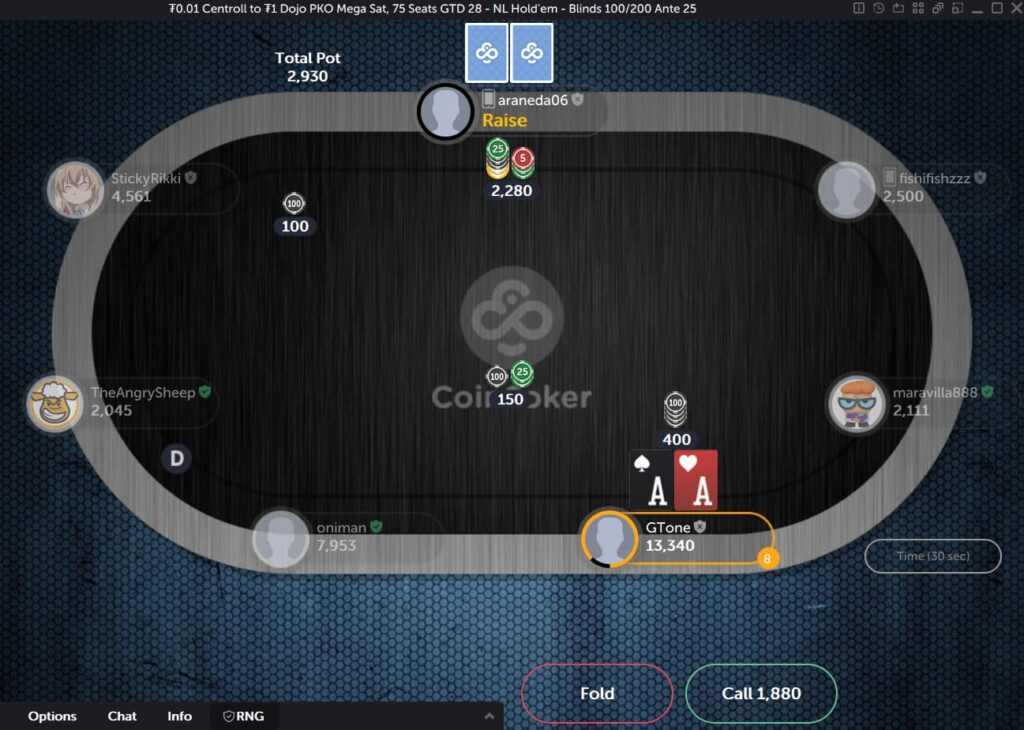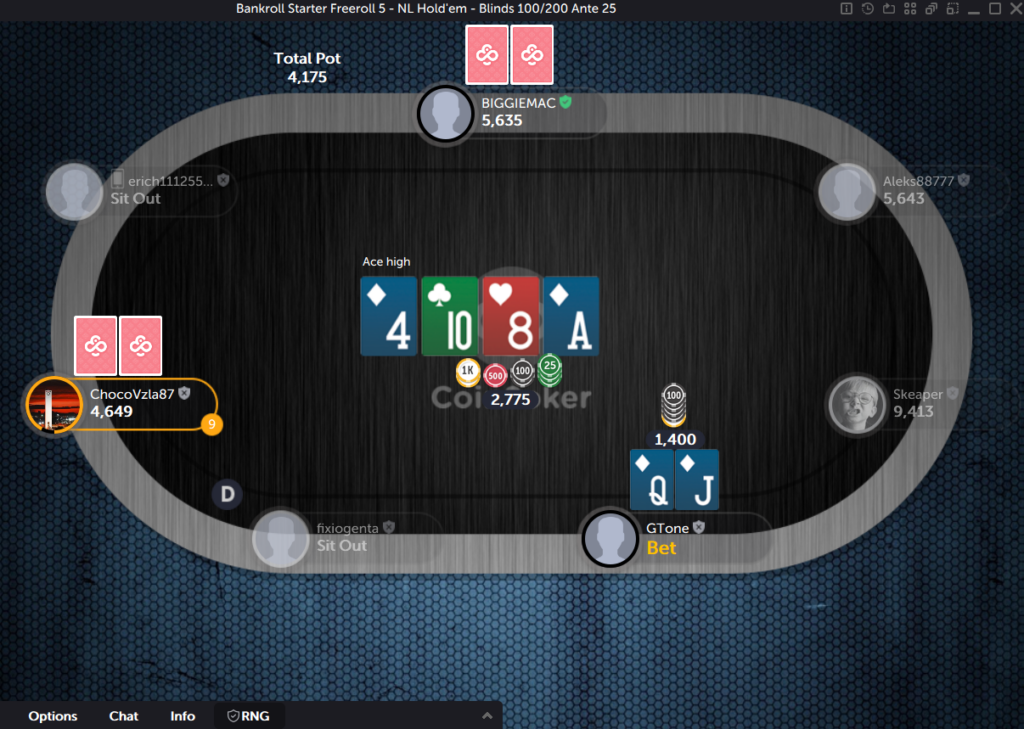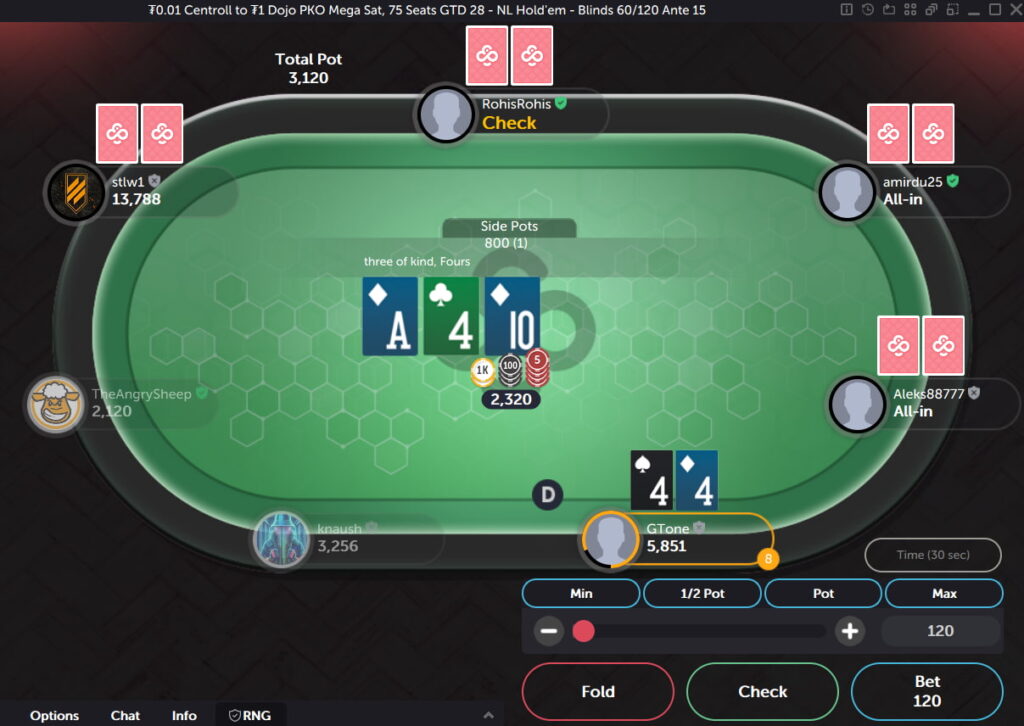Last Updated: 18 November 2024
Poker Blockers: Your Secret Weapon for Better Decision Making
Learn how poker blockers can refine your decisions, help spot bluffs, and enhance your game with strategic insights that matter.
StrategyAt CoinPoker, we know that understanding blockers can transform your game from guesswork to calculated precision. Whether you’re trying to spot bluffing opportunities or make better value bets, mastering blockers will give you a serious edge. Ready to stop playing blind and start playing smart? Let’s unlock the power of poker blockers.
What Are Blockers in Poker?
Think of poker blockers like pieces of a puzzle – when you’re holding certain cards, you’re literally blocking your opponents from having those same cards in their hand. It’s not mind reading; it’s logic. For example, if you’re holding the A♠, it’s physically impossible for your opponent to have the nut flush in spades. Pretty simple, right?
Even in preflop situations (as you’ll see below) having an Ace makes it far less likely that other players do.
But here’s where it gets interesting: poker blockers aren’t just about knowing what hands are impossible. They’re about using that information to make better decisions, spot bluffing opportunities, and avoid falling into traps. And unlike those fancy poker tells you see in movies, blockers are a concrete tool that actually works.

Quick note: Don’t confuse blockers with block bets – they’re completely different concepts. Blockers are about card removal effects, while blocking bets are a type of defensive betting strategy.
Example of Poker Blockers in a Game
Let’s see blockers in action with a common scenario you might encounter at the tables:
You hold: A♠A♦ and the board shows J♠T♠2♥7♣3♠. Your opponent makes a big river bet
Here’s why blockers matter in this spot:
- You have the A♠, blocking the strongest flush combination.
- Your opponent can’t have A♠X♠ combinations.
- This makes their value range weaker.
- They’re more likely to be bluffing.
- You might call lighter (with a less strong hand) because you block their strongest hands.
The beauty of blockers in this situation is how they narrow down possibilities. While your opponent could still have plenty of strong hands, you know exactly what they can’t have. This is particularly powerful on flush-possible boards where removing key suited cards significantly impacts possible combinations. This is blockers at work – using card removal to make more informed decisions.
How Blockers and Ranges Work
When we talk about poker ranges, we’re discussing all possible hands an opponent could have. Blockers help us narrow these ranges down. Every card you hold removes combinations from your opponent’s possible hands, making range analysis more precise and powerful.
For example:
- With no blockers: Your opponent can have 6 combinations of AA.
- If you hold one Ace: Your opponent can only have 3 combinations.
Understanding these numbers helps you make better decisions based on probability rather than gut feeling. This mathematical approach to poker is what separates professional players from amateurs who rely solely on intuition.
How to Use Poker Blockers for Bluffing
Ready to put blockers to work? Poker blockers can be helpful for making tough calls, but they’ll also strengthen your bluffs. The best bluffing opportunities often come when you’re holding cards that block your opponent’s strongest hands. Here’s a quick strategy guide for blocker-based bluffing:
- Bluff when you hold cards that would make strong hands in your opponent’s range less likely.
- Target spots where you block multiple strong combinations.
- Use blockers to identify spots where opponents are capped (can’t have the strongest combinations).
- Consider position and previous action when planning blocker bluffs.
- Adjust your bluffing frequency based on how many combinations you block.
Here’s a prime example: You have A♥K♣ on a 9♥8♥7♥ board. Since you hold the A♥, you know your opponent can’t have the nut flush. This might be a perfect bluffing opportunity because you’ve blocked their strongest possible hand. Without the nuts, your opponent will have a tougher decision to make, which improves your bluff.
Remember to combine blocker information with other factors like board texture and opponent tendencies.
How to Use Poker Blockers for Value Betting
Blockers aren’t just for bluffing – they’re important for value betting too. When value betting, you want your opponents to have second-best hands they can call with. Here’s how to use blockers for maximum value:
- Value Bet Bigger When You Block Strong Hands: When you block your opponent’s strongest possible hands, you can value bet bigger because you’re less likely to face a stronger hand that would raise. Expect calls from slightly weaker hands, such as middle pairs or weak top pairs, which still feel confident calling your bet.
- Bet Smaller When You Block Their Calling Range: If you block a portion of their calling range (such as strong draws or top pairs), you can reduce your bet size. This may induce calls from even weaker hands that wouldn’t normally continue in the pot, allowing you to extract value from hands that are likely to fold to a larger bet.
- Consider Unblocked Combinations: Pay attention to unblocked combinations (hands your cards don’t block) when sizing your bets. If you hold cards that aren’t part of the likely combinations of hands your opponent could have, this means your bet sizing can target those unblocked hands, increasing the chance of a call from weaker holdings.
- Caution with Blocker Information: While blockers are a useful tool, be cautious not to overvalue them. Just because you block a specific hand doesn’t guarantee your opponent won’t have a different strong hand in their range. Also, keep in mind that some players may still call with hands that seem unlikely to have value, especially in situations where they feel pot committed.
- Adjust Sizing Based on Blocked Combinations: Adjust your bet sizing based on the combinations of hands you’ve blocked, but be mindful of how the entire board and the action before you could influence your opponent’s range. Sometimes, a slight overestimation of your blockers can lead to a sizing mistake, especially if the opponent’s hand range is more complex than it initially seems.
Thinking About Poker Blockers Preflop
Blockers start working their magic before the flop. Smart players use them to make better preflop decisions, especially in 3-bet and 4-bet pots. Here’s your complete preflop blocker strategy:
- Blockers to Premium Hands: Holding cards like Aces or Kings blocks strong starting hands like AK and AA, which can influence your 3-bet or 4-bet decision. This makes it more likely your opponents are holding weaker hands when they show aggression.
- Blockers to Hands That Could Squeeze: High cards like AK or AQ reduce the chance your opponents will have those hands in a squeeze spot, allowing you to make a more profitable 3-bet or call with a wider range.
- Consider Blockers for 3-Bet or 4-Bet Bluffing: Use blockers to identify opportunities for bluffs, especially when blocking premium hands or strong draw combinations.
Thinking About Poker Blockers Postflop
Postflop is where blocker effects really shine. As community cards appear, blocker effects become more pronounced and easier to use. Consider these key situations and their implications:
- Flush draws: Holding suited cards blocks others from having the same draw.
- Straight draws: Connected cards block similar drawing hands.
- Set mining: Holding a card from the board blocks set combinations.
- Top pair: Having one of the top pair cards blocks full house possibilities.
- Nut blockers: Holding cards that block the nuts affects bluff catching.
Let’s say you’re playing Texas Hold’em and the board shows K♠Q♠J♦. If you hold A♠T♠, you’ve not only got a straight, but you’re also blocking others from having the nut flush. This should affect both your betting and calling decisions, potentially allowing you to be more aggressive with semi-bluffs.

Common Blocker Mistakes Players Make
Even experienced players sometimes misuse blocker concepts. Here are the most common pitfalls to avoid and how to fix them:
- Overvaluing Weak Blockers: Blockers are less valuable when your opponent’s range is likely strong.
How to Fix It: Assess the strength of your opponent’s range and don’t rely on weak blockers alone. Consider the overall situation. - Ignoring Opponent Tendencies in Favor of Pure Blocker Math: Blockers can mislead if you ignore how your opponent plays.
How to Fix It: Factor in your opponent’s tendencies and adjust accordingly instead of focusing only on blockers. - Making Hero Calls Just Because You Have a Blocker: A blocker doesn’t guarantee your opponent is bluffing.
How to Fix It: Don’t base calls solely on a blocker; consider the opponent’s actions and overall betting patterns. - Bluffing with Blockers Against Calling Stations: Bluffing with blockers is ineffective against players who call with weak hands.
How to Fix It: Avoid bluffing in spots where your opponent is likely to call with worse hands. - Forgetting About Blockers When Sizing Value Bets: Blockers should influence your bet sizing.
How to Fix It: Use blockers to adjust your bet size, increasing it when you block strong hands, or reducing it when you limit their calling range. - Using Blockers as the Sole Decision-Making Factor: Blockers should complement, not dominate, your decision-making.
How to Fix It: Integrate blockers into a broader strategy, considering the full context of the hand and opponent tendencies. - Neglecting Position and Stack Depth Considerations: Blockers can be overemphasized when position and stack depth are more important.
How to Fix It: Account for your position and stack size in relation to blockers when making decisions. - Overestimating the Impact of Single Card Blockers: A single card blocker doesn’t always have a big impact.
How to Fix It: Realistically evaluate the blocker’s influence on your opponent’s range before relying on it.
Remember blockers are just one piece of the puzzle. They don’t guarantee anything – they just help you make more informed decisions. Just because you block the nuts doesn’t mean your opponent is always bluffing! Always consider the complete context of the hand and your opponent’s tendencies before making critical decisions.
What is Unblocking in Poker?
While blockers tell us what hands opponents can’t have, unblocking tells us what hands they’re more likely to have. When you don’t hold cards that would block certain combinations, those combinations become more likely in your opponent’s range.
For example, if you hold 7♦6♦ on a K♥Q♥J♥ board, you don’t block any flush combinations, so it’s more likely that your opponent could have a flush. At the same time, you don’t block any of the straights or the sets, leaving many possible hands in your opponent’s range. If you were holding the A♥, however, you’d be blocking their ability to make the nut flush. Understanding this concept will be helpful when:
- Identifying good bluff-catching opportunities
- Spotting when opponents are more likely to have strong hands
- Making better hero-calling decisions
- Planning your bluffs more effectively
- Adjusting your calling ranges appropriately
- Understanding opponent tendencies better
- Making more informed river decisions
The concept of unblocking is particularly powerful in multiway pots where multiple ranges interact.
In the gameplay below, you’ll see a spot where having a set of Fours is unblocking pairs of Aces and pairs of Tens – a perfect opportunity to get value.

Practice Using Poker Blockers in Real Games
Remember, mastering blockers takes time and practice. But with each hand you play, you’ll get better at using this powerful tool to make more profitable decisions. The sooner you start implementing these concepts, the sooner you’ll see improvement in your win rate!
Ready to put your blocker knowledge to work? Join us at CoinPoker where you can practice these concepts at stakes that suit your comfort level. Start with simple blocker applications and gradually incorporate more complex concepts as you gain confidence.
FAQs
Blockers are cards you hold that prevent opponents from having certain combinations, affecting their possible range of hands. They’re essential tools for modern poker strategy and help inform decision-making throughout a hand.
They help you make better decisions by knowing what hands are impossible for opponents to have. This information can guide your bluffing, calling, and value betting decisions across all streets.
Use blockers when making critical decisions about bluffing, calling, or sizing value bets. They’re particularly important in large pots and when facing significant betting action.
Yes, but they’re more important against thinking players who play balanced ranges. While they matter less against purely recreational players, understanding blockers will help you as you move up in stakes.
Blockers matter in both situations but become more powerful postflop as ranges narrow and decisions become more critical. They’re particularly important on later streets when making thin value bets or hero calls.
Explore More
Announcements
Read recent announcements from CoinPoker about new games, ambassadors, and changes to our platform.
8 PostsGuides
The go-to resource for mastering poker with expert tips and strategies. Whether you're a beginner or a pro, our guides will elevate your skill level.
60 PostsNews
Find the latest poker news, plus our latest CoinPoker Weekly and Monthly Newsletters. Updates about games, promotions and other exciting crypto news.
90 PostsPromotions
Find the latest coinpoker promotions here. Explore the crypto poker world with the best poker promotions available.
1 Post
















